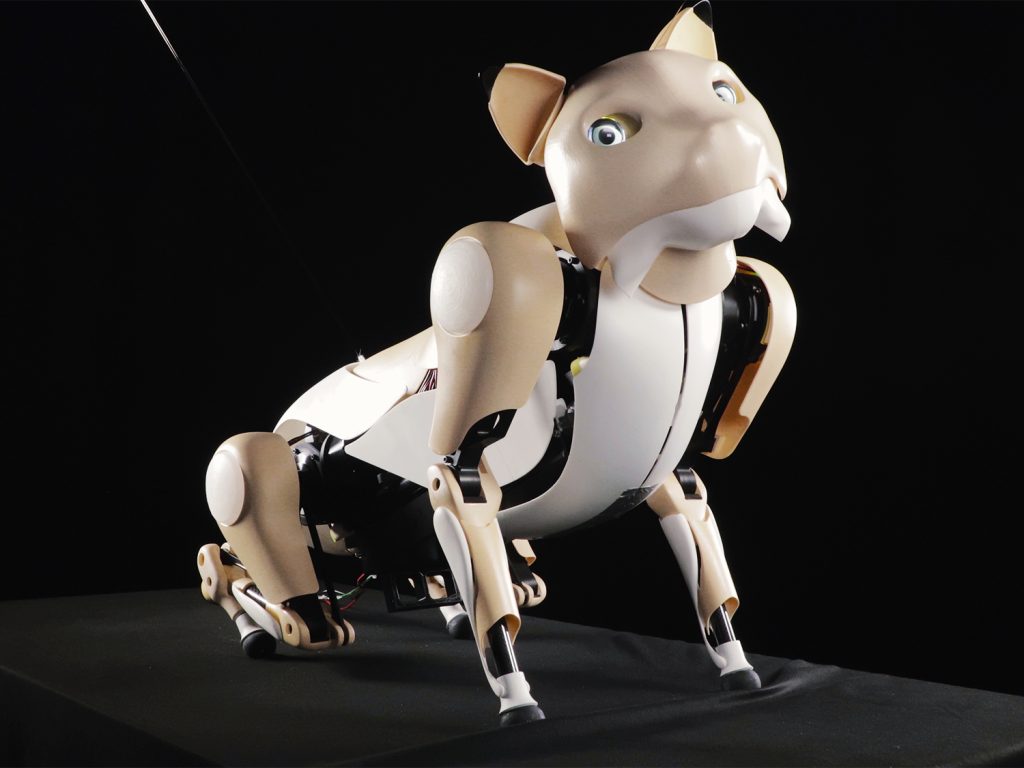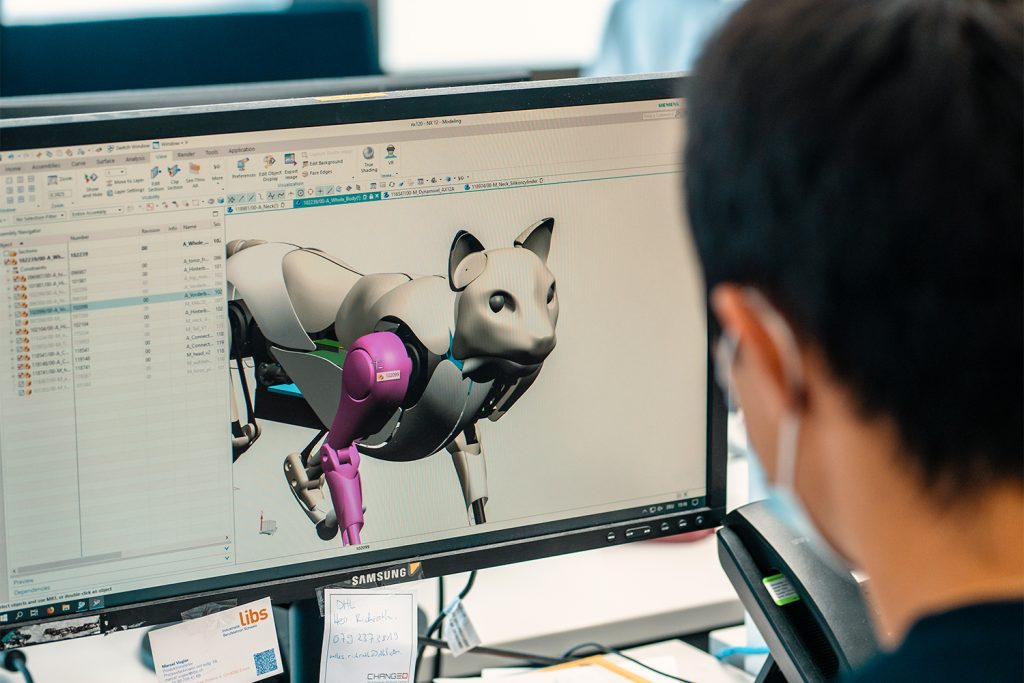Researchers at ETH Zurich have used 3D printing to build an autonomous cat-like robot that’s capable of imitating the movements of real-life felines.
3D printed using SLS, FDM and MJF over nine months, the ‘Dyana’ bot features impact resistant thigh pads, which allow it to run freely without risking one of its nine lives. More predator than house cat in size, the droid is able to enact computer-animated movements and has its own programmable ‘character,’ which is designed to combine animation and robotics in a novel ‘animatronics’ application.
“There’s huge potential in the design and character [of Dyana],” explains Andrina Grimm, Technical Lead on the project. “We want to build characters in the real world, and create a system where you can add different characters, and have different emotions shown on a robot.”
Fusing AM with animatronics
Dyana has been built as part of an interdisciplinary focus project between ETH Zurich, the Zurich University of Applied Sciences, Zurich University of the Arts and the University of Applied Sciences Northwestern Switzerland, involving a total of fourteen bachelor students. Each of these engineers were new to animatronics, a field that’s essentially dedicated to the creation of lifelike robots, which move in a natural rather than a robotic way.
Aiming to progress towards this wider goal, the Dyana project’s mechanical and design lead Andrina Grimm, says that her team set out to “combine the field of animation and characters from movies, with robots that are agile and able to move around in the real world,” and develop a unique character “that moves on its own.”
However, she adds that one of the main challenges facing animatronics engineers is making the resulting robots capable of playing back pre-animated movements, and ‘walking’ in the real world. Such bots also need to be robust, so that they don’t capitulate under repetitive loads, and in the case of the ETH Zurich project, the team faced a nine-month deadline that required Dyana to be rapidly produced.

Fabricating a feline companion
In order to construct Dyana as quickly and with as much design freedom as possible, the student engineers began by 3D modelling their bot, before going on to 3D print its polymeric shell. Doing so allowed the team to connect the robotic feline’s interfaces and curved outer plating in a streamlined way, and according to Grimm, this also enabled them to “add a character and feeling to its whole body.”
At different stages of the project, the team utilized the FDM, MJF and SLS technologies, allowing them to rapidly iterate their cat-bot’s design, but it was the latter that was eventually used to create its outer shell, due to the ultra-lightweight parts it was found to yield.
“SLS technology was used for the thighs and shoulders,” explains Grimm. “With PA12, we were able to get parts that were sturdy enough for the robot to sustain impacts, yet flexible enough to support curved surfaces.”
“With Sintratec technology we were able to design freely and get sturdy, yet lightweight parts – ideal properties for building robots.”
Laser sintered using Sintratec systems, these robotic thighs feature dedicated spaces for mechanical interfaces, and an end-use ready finish that meant they didn’t require sanding before application. Once printed, the parts were spray painted, combined with silicone pads and attached to Dyana, in a process that resulted in a body which outperforms those of traditional molded thermoplast-made bots.
“In our project, we showed that it is possible to use 3D printing to create a shell for a robot, which has not been done before,” concluded Grimm. “While before, a thermoplast has been used, with 3D printing we still have sturdy parts but they are also flexible, and they don’t break easily in impacts.”
Although the current version of Dyana is capable of carrying out movements that appear to be natural, the team continues to work on enabling it to perform these independently. As a result, the engineers haven’t quite fulfilled their animatronic aims just yet, but they still harbor ambitions of creating a process of uploading ‘emotions’ into bots, something they think could be plausible in future.

It’s raining cats and dogs
While ETH Zurich’s animatronic cat represents a pretty unique application of 3D printing, it may surprise readers to learn that the technology has been used to create several robotic versions of man’s best friend as well. Just last month, XRobots’ James Bruton unveiled the third version of his ‘openDog’ robotic canine, which can be 3D printed utilizing an everyday LulzBot TAZ Workhorse machine.
Similarly, in February 2020, researchers at NYU’s Tandon School of Engineering and the Max Planck Institute for Intelligent Systems, revealed their own ‘Solo 8’ open-source robotic dog. Built with a 3D printed shell, a smattering of low-cost off-the-shelf parts and a simplified modular assembly, the robot companion was designed as a competitor to Boston Dynamics’ offering, which is priced at around $75,000.
When it comes to making sentient animatronics, scientists at Florida Atlantic University have managed to make a significant advance by using AI algorithms to create ‘Astro,’ an intelligent robot dog. Featuring a Doberman-like 3D printed head with a computer-simulated brain, Astro can reportedly be trained to respond to vocal inputs or visual signals.
To stay up to date with the latest 3D printing news, don’t forget to subscribe to the 3D Printing Industry newsletter or follow us on Twitter or liking our page on Facebook.
For a deeper dive into additive manufacturing, you can now subscribe to our Youtube channel, featuring discussion, debriefs, and shots of 3D printing in-action.
Are you looking for a job in the additive manufacturing industry? Visit 3D Printing Jobs for a selection of roles in the industry.
Featured image shows ETH Zurich’s Andrina Grimm alongside her ‘Dyana’ robotic cat. Photo via Sintratec.


